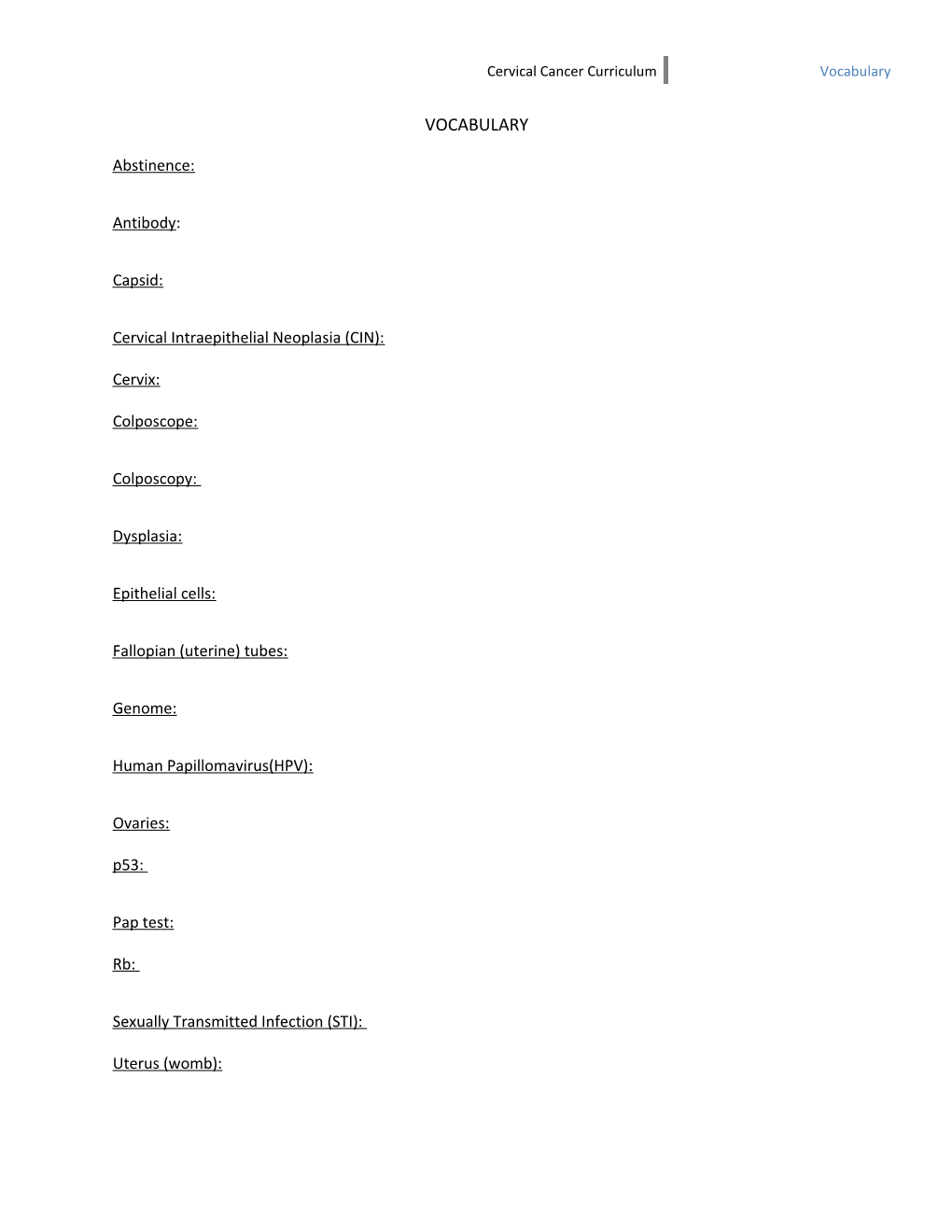VOCABULARY
Abstinence:
Antibody:
Capsid:
Cervical Intraepithelial Neoplasia (CIN):
Cervix:
Colposcope:
Colposcopy:
Dysplasia:
Epithelial cells:
Fallopian (uterine) tubes:
Genome:
Human Papillomavirus(HPV):
Ovaries:
p53:
Pap test:
Rb:
Sexually Transmitted Infection (STI):
Uterus (womb):
Vaccine:
Vagina:
Virus:
VOCABULARY: Answer Key
Abstinence:refraining from sexual intercourse
Antibody: a protein produced by B lymphocytes (B cells); antibodies bind to and inactivate foreign objects that enter the body
Capsid: protein shell that surrounds and protects a viral genome
Cervical Intraepithelial Neoplasia (CIN): A condition characterized by abnormal cell division that may develop into cancer over time or may return to normal. CIN is categorized by its severity into three stages, CIN1, CIN2 and CIN3.
Cervix: region connecting the uterus to the vagina; the muscles of the cervix support the weight of the fetus (developing baby) during pregnancy
Colposcope: a device with a light and magnifying lens that allows doctors to visually inspect the cervix
Colposcopy:a visual examination of the cervix using a colposcope.
Dysplasia: often called pre-cancer; early stages of abnormal cell function resulting in changes of cellular and tissue morphology;
Epithelial cells: cells located mainly at the surfaces that cover the body or individual organs. Function as selective barriers, regulating exchange of molecules.
Fallopian (uterine) tubes: location of fertilization of an egg by a sperm cell
Genome: entire collection of genetic information carried by an individual or cell
Human Papillomavirus(HPV):a sexually transmitted virus that is known to cause cervical cancer.
Ovaries: produce, store and release gametes (eggs). The ovaries also produce the female sex hormones, estrogen and progesterone
p53: a protein that controls responses to different types of cellular stress including DNA damage and viral infection
Pap test: a technique used to detect cervical cancer; a broom shaped brush or spatula is inserted through the vagina and cells are wiped from the cervix and preserved on a slide or in a vial.
Rb:a protein that can prevent cell division by blocking the activity of transcription factors
Sexually Transmitted Infection (STI): an infection, viral, fungal or bacterial, transmitted primarily by sexual contact; such as HIV, HPV, Gonorrhea, or Chlamydia.
Uterus (womb): location where fertilized egg develops into a fetus and is nourished until birth
Vaccine: a mixture of killed or weakened bacteria/viruses or specific parts of bacteria/viruses, injected to induce antibodies and cellular activities that provide immunity against the pathogen (bacteria/virus)
Vagina: female sex organ; passageway for menstrual blood and the baby during childbirth
Virus: infectious agent composed of a protein shell and a nucleic acid; viruses are totally dependent on living cells for reproduction.
